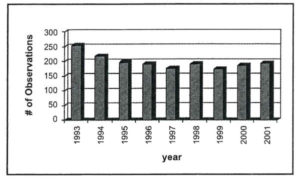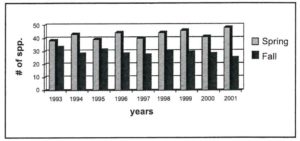Oaks ‘n Folks – Volume 18, Issue 12 – July, 2002
Throughout northern coastal California, a great deal of information regarding water quality and fish habitat is being amassed that potentially could change how people view and utilize stream corridors. However, it is widely recognized among the scientific community that stream corridors are an important habitat component for a host of vertebrate and invertebrate species other than fish. Unfortunately, the current fish-centric approach to riparian protection and restoration has often resulted in a narrow discussion of stream corridor management that excludes non-fish species. For example, information detailing the use of oak woodland stream corridors by migratory songbirds in California’s oak woodlands is sorely lacking, limiting the ability of landowners and resource managers to make informed decisions regarding land use practices and policies and their effects on birds. It is important that we consider these other species when managing and restoring riparian areas, as their requirements may be different than those of the fish.
Spring 2002 marks the tenth consecutive year of a bird monitoring study on Parson’s Creek, an ephemeral (seasonal) tributary of the Russian River that traverses the UC Hopland Research and Extension Center (HREC). The goal of this ongoing project is to document resident and migratory bird use of stream corridors in mixed oak woodlands. This article provides an overview of nine years of data collection between 1993 and 2001.
Study Site and Sampling Methods
Parson’s Creek, like most creeks in the North Coast, has been subject to many land use impacts over the past 100 years, including livestock grazing, gravel extraction, channel-ization, and road crossings with associated aggravated erosion. To offset many of these impacts, HREC instituted a series of restoration activities in the early 1990s to serve as demonstrations to landowners who are interested in stream restoration. Since then, recovery of native vegetation in some sections of Parson’s Creek has been dramatic. In areas that have excluded both sheep and deer, alder and willow have regenerated and are now providing extensive vegetative cover (see Opperman, Oaks ’n’ Folks v13, i1). Other sections were left unprotected and remain denuded, demonstrating how the restored sites used to look. Consequently, vegetative cover is not uniformly distributed throughout the stream reach. Other over-story species that exist across the study area include blue oak, Oregon white oak (also known as Garry oak), and valley oak.
Twelve monitoring points were established along the main creek channel at HREC. Birds were surveyed using a standard sampling protocol commonly referred to as the “point count method”. This method is widely used to survey birds in the field and involves an observer recording birds from a single point for a set length of time.
Each monitoring point was surveyed 3 times a year during the morning. Two 20-minute counts were conducted each spring between mid-May and early June to coincide with the arrival of migratory songbirds. In addition, one 20-minute count was conducted each fall in mid-October, after the departure of neo-tropical migrants to wintering grounds in the tropics. Birds were identified using visual and auditory cues. Only those birds active (perching, foraging, singing, etc.) within the riparian corridor were tallied. Birds flying high above or passing through the stream zone were not counted.

Findings
Between 1993 and 2001, a total of 1,779 bird observations were recorded. The total number of observations per year ranged from a high of 254 (1993) to a low of 173 (1999). The average number of recorded observations over the nine-year assessment is 198 detections per year (Figure 1). The unusually high number of recorded observations in 1993 is most likely an aberration of sampling, not a trend in bird presence. Following the first year, the observers became more conservative and standardized in their data collection.

The large number of bird detections yielded an impressive number of species—81 species, representing 24 taxonomic families and 9 orders. Both resident and migratory species were detected in the oak woodland stream corridor. Species most commonly observed and the corresponding number of detections during the study period is provided in Table 1.
Table 1. Most commonly observed species in the Parson’s Creek riparian corridor, HREC. 1993-2001.
|
During the study period, an average of 29 species (ranging from 27 to 33) were detected during the Fall. These species are primarily resident birds that utilize the stream corridor throughout the year. Spring counts averaged 43 species (ranging from 38 to 48). The difference in the average total number of species detected could be due in part to the differences in sampling effort and may also reflect the seasonal influx of neotropical migratory songbirds that arrive in California’s oak woodlands for the breeding season.
We also found that some species may be selectively utilizing only portions of the riparian corridor that exhibit special habitat features. For instance, one species in particular, the Black-throated Gary Warbler (Dendroica nigrescens), is consistently found only in those portions of the riparian area where the vegetation canopy is densest. This pattern of occurrence has remained consistent during the entire study period, and suggests that this species may have relatively narrow habitat requirements when compared to other neotropical migrants exploiting the stream corridor.
In Conclusion
There is very little long-term information detailing the use of oak woodland stream corridors by migratory and resident birds in California’s oak woodlands. Our long-term data set demonstrates that migratory songbirds readily utilize the riparian zone, particularly during the spring breeding season. There appears to be differences in the number of species found during the spring and fall within the study site. We also observed that some species are more abundant in sections of the creek where more mature vegetation is present.
We plan to continue to monitor the avian assemblage found within this stream corridor. It is our hope that this project, along with the efforts of others, will generate important, long-term, baseline information that will aid in the sustainable management of California’s riparian hardwood communities.
prepared and edited by Adina Merenlender and Emily Heaton
